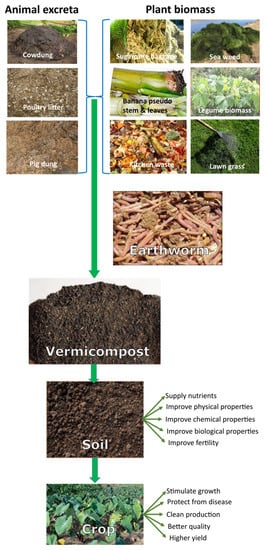Vermicompost has high concentrations of humus, nitrogen (2–3%), phosphorous (1.55–2.25%), potassium (1.85–2.25%), micronutrients, and beneficial soil microbes such as nitrogen-fixing bacteria, mycorrhizal fungi, phosphate solubilizing bacteria, and actinomycetes
[4][17]. Bio-oxidation and stabilization of organic matter and biomass occur during the vermicomposting process and increase enzymatic activities such as amylase, lipase, cellulose, chitinase, urease, dehydrogenase and phosphatase, and microbial populations
[4][18][19]. For example, vermicomposting stimulates nitrogenase enzyme activity, and therefore nitrogen mineralization and nitrogen availability. Mineralization of nitrogen induces phosphorus availability and uptake. Additionally, vermicomposting also increases the availability of other nutrients such as soluble potassium, nitrates, calcium, and magnesium
[20]. Vermicompost application increases the availability of nitrogen in soil mostly in the form of nitrate relative to ammonium due to better soil aeration
[16]. Plots treated with vermicompost showed higher levels of total N
[21]. In parallel, phosphorus was shown to be more available, and it was released in large amounts due to microorganism activity
[4]. Interestingly, reports have shown that when vermicompost is applied in combination with commercial NPK fertilizer, nitrogen availability improved to a greater extent than when only NPK fertilizer was applied
[22]. It has also been proposed that, due to the slow mineralization of N with the use of vermicompost, its application leads to improved crop yields and an increase in plant leaf area and number of leaves per plant
[22]. Furthermore, with the application of vermicompost, the organic matter releases the nutrients slowly and steadily into the soil and allows the plants to absorb the available nutrients. Hence, the application of vermicompost leads to an increase in cation exchange capacity
[23]. High activity of basic cations, e.g., Ca, Mg, K etc., was also reported in the vermicast (earthworms castings) compared to soil
[24].
Vermicompost has been included in plant nutrient management programs in large-scale greenhouse production systems. For both fruit and vegetable crops cultivated in greenhouses, when vermicompost is used as a growing medium alone or in combination with soil, it has been shown to improve the release and availability of plant nutrients. Hence, a fertigation practice in greenhouse production systems that includes vermicompost would substitute other plant nutrients within the range of 20–40%. Under large open field conditions, vermicompost is typically applied to soil at a rate of 1–5 tons ha
−1 yr
−1 [25]), unless the soil is unfertile where it is applied in larger doses. The application of vermicompost significantly improves the organic carbon content in soil as it is enriched with stable organic matter
[20][26]. The application of fully decomposed vermicompost has been shown to reduce the loss of nutrients through leaching
[16], due to an increase in total soil organic carbon
[27]. In addition, vermicompost helps to remediate the stability of the soil from toxicity
[28]. This shows that the application of vermicompost in soil enhances soil physicochemical properties and biological activities, and, thereby, crop production
[29]. It has been reported that the population of microbes is more than three times greater where vermicompost is applied compared with a control (only soil)
[30].
Nonetheless, there are reasons to approach the use of vermicompost with caution
[31]. A few studies have shown negative impacts on plants and soil, typically related to the quantity of vermicompost applied. The application of higher percentages of vermicompost could create an uncomfortable zone for root growth, which directly induces phytotoxicity
[32][33]. Furthermore, high concentrations of vermicompost could result in the rapid destruction of the plant due to the accumulation of salt in the soil.

